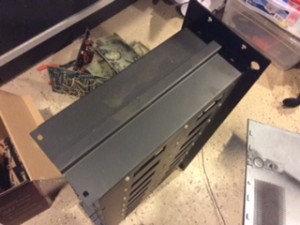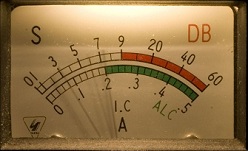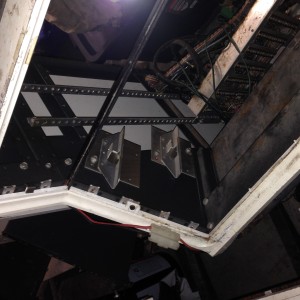I decided that it’s time to reconfigure the shack… this time using dispatch consoles. The main purpose is to limit the surfaces I can pile things on – and cut the clutter. This started when a couple of us stumbled across a set of 4 Motorola empty Centracom Series II consoles on www.govdeals.com. Since I wanted a right angle configuration in the corner, this required, in addition to the consoles, two 45 degree wedges. Once I got the Centracom II consoles in place, I happened across a set of 3 populated and 1 empty Centracom Series I consoles. The racks almost matched (close enough?), so I wasn’t too concerned with the slight differences.
The interesting thing about the populated consoles was the way the various parts worked. There were a good number of speakers, control panels (buttons and knobs), and clocks/VU meters). I started by pulling out the miscellaneous PL tone cards, etc., since I am not interfacing to normal radios for those systems, said cards would be less than useful. In addition, the racks had the original Centracom power supplies – heavy, and lots of different voltages. I decided to ditch these, unless I find out later that these voltages and supplies cannot be replicated using another method.
The speakers all had amplifiers mounted in the same enclosure, but since I planned on running these speakers connected to local radios with speaker level outputs already, I did not need those cards. It was easy to remove the speaker wires from the cards, and remove the cards form the speaker panel.
The Clock/VU meter assemblies were a little more interesting. While I don’t have a real signal strength output for the scanner or other radios, it seemed that connecting the meter to a speaker output would make it move with received signal. The clock, on the other hand, looked like it would present a challenge, until I realized that it only uses 3 wires – power +/- and sync. Looking up a datasheet on the chip showed that it synchronizes of 60 Hz – so I would need a low voltage AC signal. This required a trip to gateway electronics… but first, I had to show that the clock was functional. Connection of a 9V battery showed that, while functional, some of the segments had been damaged. Add a couple standard segmented displays to the shopping list (actually, it also appeared that some of the traces were damaged) – I got 2 such modules, and the other wasn’t functional at all, so care had to be taken. I decided that, though cool, this would be shelved until later, since I’m still looking for the corner section.
I really wanted to install a scanner in one of the rack panels, and then have audio served around my LAN either in the form of a shoutcast server, or just allow remote control of the scanner. The real challenge here is doing so without the serious audio processing lag that I noted with many shoutcast servers. It seemed that this one radio would be serving a lot of things… which required a bit of thought.
The HF station, though using no centracom electronics (except maybe a speaker, I’m still experimenting with the overall system setup), still proved interesting. My station primarily consists of an FT1000, an SB220 Amplifier, and a Palstar AT-2K tuner. It turned out that the Palstar fits perfectly on a 3U rack shelf, as long as the feet are removed. The other two pieces of equipment added a bit of a challenge. After some web searching, I found Bob at www.novexcomm.com – builder of all kinds of custom panels. Bob and I spent several hours on the phone and email tossing ideas back and forth. He already had the FT1000 rack panel system in stock, so that was easy. The SB220, however, was a different story. While Bob had done amplifiers before, he had not done this one specifically. It turns out that the overall rack mount was going to need to be an 8U (10.5”) panel.
One nice thing about Centracom series I consoles is the internal rack guides – there is a pair of brackets bolted to the actual rack frame for each 3U centracom card cage – this takes a majority of the load of the weight of the equipment off the front panel. The result of this is that the load on the front panel is just keeping the equipment from sliding any further into the rack, with most of the weight being transferred to the brackets in the rack. The photo below shows a Centracom I card cage from the side – showing the “rails” on the side of the cage, which sit on the Centracom Rack guides

The next photo shows the rack guides in a rack, Note that they are installed in the sloped portion of the rack:
In order to make the system more robust, we worked out a method to utilize the Centracom’s internal rack guides to support the aft end of the amplifier. Some modifications had to be made to the brackets, since the space between them is 16.75”, and the Novexcomm rack tray is 17” wide – but this only required knocking 0.2” off each bracket – and the brackets were 1” deep.
Possibly the easiest component to work with was the AT2K antenna tuner. The vertical part of the Centracom console is set up for a 3U rack panel. The AT2K just happens to be about ½” less than 3U in height, less the feet. I happened on a 3U rack shelf that had sufficient depth for the tuner – I removed the feet from the tuner, and drilled the rack shelf for the bottom of the tuner, so the tuner is mounted using the same holes as the feet. The final part of this was coming up with a “frame” to cover the gaps on the sides of the tuner within the rack shelf, and fill the slot at the top of the mount, as well. The one challenge this scheme presented was that the shelf tolerances actually caused the tuner to intrude into the space that the sloped area below needed – fortunately, this was easily handled by notching the top 1U filler above the tuner.

